 UK Geoists are crowdsourcing a film about the nature and benefits resulting from a tax on the value of land. You needn’t be a UK resident nor have a UK charge card in order to support this. Seeking a total of £9000, they’ve already got £2188 with 18 days to go. Join the 46 funders so far, or find out more, here.
UK Geoists are crowdsourcing a film about the nature and benefits resulting from a tax on the value of land. You needn’t be a UK resident nor have a UK charge card in order to support this. Seeking a total of £9000, they’ve already got £2188 with 18 days to go. Join the 46 funders so far, or find out more, here.
Category: taxes
I’m from the government and I’m here to deceive you
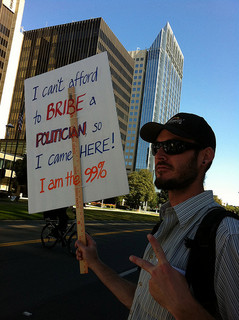
They call it “Factors Influencing Voluntary Compliance by Small Businesses[pdf],” and the report comes from IRS (actually “an independent organization within IRS,” whatever that means), and so you know that it’s referring to compliance with Federal income tax laws and regulations.
The focus on small business makes sense, since folks on payrolls or pensions generally can’t hide much of their income, and large corporations can obtain legislative action or legal advice providing their own loopholes. Two surveys were done, one of small businesspeople nationwide for whom, statistically, an audit would be expected to result in additional tax payments, and the other of small businesspeople in communities from which a high proportion of such returns was filed. (NOTE: When wooing their votes we call them “entrepreneurs” or “job creators,” but that would not be dainty when we are considering them “tax cheats.”) These “low compliance” folks were supplemented by a survey of those expected to be “high compliance.”
I see two surprising results in this report. First, on most attitude measures there’s little difference between the “low compliance” and “high compliance” respondents. For example, only 15% of the “low” group thought that federal tax laws were fair, and the same proportion of the “high” group agreed. Differences that did appear were fairly small. “Wealthy taxpayers minimize their taxes in ways the average taxpayer cannot” was agreed with by 74% of the “low compliance”‘ group, and 69% of the “high compliance” people.
An even bigger surprise, to the IRS analysts as well as this blogger, is that “low compliance” seems to be associated with greater participation in their local communities, including churches, schools, volunteer organizations, and even were more likely to vote than “high compliance” people. I hesitate to speculate on what this means, but it is probably a positive for those of us who believe (along with most respondents) that federal government is not an appropriate way to deal with many of the areas it has become involved in.
The report acknowledges that the survey suffers from an indirect method: “Low compliance” merely indicates a statistical likelihood of same, not an actual lack of compliance by the respondent. Because a random selection of taxpayers are audited simply to calibrate the compliance-prediction model, it would have been possible to target these particular taxpayers for the survey. Of course they couldn’t be surveyed after their audits because they might be especially unhappy with IRS at that point. But they could have been surveyed just before being notified on the audit. IRS decided not to do that because they “deemed it overly deceptive.” However, the actual survey (done over the phone by a contracted private company), did not reveal that this was an IRS project until the conclusion, after the data had been gathered. That apparently was deemed just deceptive enough.
Not part of the published report is a list of “clusters of potential tax cheats” posted by AP but presumably originating with IRS. Apparently tabulated by zip code, here’s the Illinois portion of the list:
Bellwood, Calumet City, Dolton, Grand Crossing, Hazel Crest, Matteson, Maywood, Ogden Park, Phoenix, Riverdale, Roseland, South Chicago Heights, South Holland, University Park. I assume that folks in Oakbrook and Barrington Hills had already purchased their own loopholes.
“We need an anti-Rentier Campaign” says Michael Lind

A nice series of three short articles (h/t Gloria Picchetti) in Salon by Michael Lind, explaining the difference between an entrepreneur — who may become wealthy by providing goods and services people want — and a rentier — who seeks to become rich by exacting a toll or tax on productive work.
Lind mentions, in a positive way, the land value tax, and also notes that this isn’t a left/right issue, as labor unions and professional associations can be just as monopolistic as bankers. The negative effects of “intellectual” “property” are noted, altho Lind seems to think that those who profit from patents are “inventors.” Of course there’s no mention of Henry George, but maybe changing our name to “Institute for the Study and Extirpation of the Useless Rich” would be a helpful step.
Salon describes Michael Lind as author of Land of Promise, for which Amazon carries 15 reader reviews. Not all the reviews are positive, but the criticisms seem to focus on his style and attitude, nobody complaining that his analysis is flawed. Lind is also a “co-founder of the New America Foundation,” whose sources of funding are unclear to me but seem to include rentier George Soros.
The remedies Lind suggests are quite centralized, such as changing federal tax laws, and maintaining financial repression with the object of moving people from private savings to social programs. Not what I would propose, but what does a geoist in flyover country have to contribute to this discussion?
Curious land tenure arrangement at Glencoe

As reported yesterday by Chris Jones of the Tribune, Writers’ Theater is planning a new $30 million home on the site of the Glencoe Women’s Library Club. Being ignorant of things theatrical, I find the interesting part of Jones’ article to be
The building would rise on the Tudor Court site of the Glencoe Woman’s Library Club, which, unusually, would continue to own the land after its building was demolished. Writers’ Theatre would be granted a 99-year lease, with a rent of $1 a year.
Construction of buildings on leased land isn’t all that uncommon, and 99 years is a typical term. But at a rent of $1/year, this obviously isn’t an investment decision. And as (presumably) a nonprofit association, neither the Club’s members nor their heirs can expect to benefit from an increase in the selling price of land by the year 2111. The now-unborn who will be members of the club at that time might benefit, but it’s hard to imagine current members thinking that way.
So there must be something else involved. Perhaps the Theater will be obligated to provide some space to the club, or perhaps the land title is encumbered so that it cannot be donated. Probably if we had all the information we’d find some implications for elaborate income tax trusts of some kind that were advantageous to someone in the past. Hopefully someone will come up with more information.
Jones also notes that the location is “not far from the Metra/Union Pacific train tracks,” which implies that theatergoers could ride Metra to and from performances. Perhaps, if they’re lucky as to where they live and when the show ends, but the Metra service is sparse and nighttime connecting bus service essentially nil in the north suburbs. Patrons who dine in any restaurant or bar before or after the show will have the opportunity, however, to pay some of the costs of providing the uncoordinated, inconvenient service.
Are subsidies driving Chicago land prices back up?

Of course they are, but it’s convenient to see it illustrated as Crains Chicago Real Estate Daily explains.
The proposal seems to be for Pam Gleichman and Karl Norberg to sell their 4.9 acre parcel (the Tribune story says 3.67 acres) near McCormick Place, in pieces, for a total of $195 million, which works out to something over $900/square foot, a level which I don’t recall seeing so distant from the loop. We also learn from Crains that $90 million in TIF (real estate tax) money will be sought to help pay for these developments. And of course the entire McCormick Place complex benefits from the 1% tax which all restaurant patrons in the central portion of Chicago (as far north as Diversey and as far west as Ashland) pay, not to mention the basic urban services, such as fire protection, transit, and streets, which are funded from other taxes. We’re all paying so Gleichman and Norberg can get their $195 million. It’s only slightly comforting to realize that their venture is in bankruptcy, and the only reason we get to see these details is because they’re part of a court filing. But it seems that, if everything works out as they claim, they’ll get to keep a large portion of this money.
Just for fun, we can consider what would have happened under a land value tax. If the land was taxed at something approaching its full economic rent, it would likely already be developed pretty fully because nobody could profit by holding it underused. There would likely be no bankruptcy because nobody would have loaned money on land with a modest selling price.
Transaction taxes

Proposals for a small tax on investment transactions seem to make some sense. Ordinary investors, small or large, are likely to buy or sell a small percentage of their holdings each month or year, while high-frequency traders could turn over theirs dozens of times per day. A tax of, say, 0.1% would hardly be noticed by investors, but could make high-frequency trading (HFT) unworkable. If HFT helps destabilize financial markets, then taxing trades this way would raise some revenue while improving economic stability.
Though I don’t see such a tax as consistent with geoist principles, it seems a lot less damaging than many of the taxes we already face. The problem is that it cannot be enforced. Trades can always be done in some way “off the books,” probably legally but otherwise if necessary. Since those who benefit from HFT also have resources to control relevant regulatory decisions, any such tax will have loopholes or other means to prevent effective enforcement.
Sure enough,
most investment banks offer significant UK traders “contracts-for-difference” which are contracts that precisely simulate equity ownership while circumventing UK taxes on transactions (“Stamp Duty”).
— J Doyne Farmer and Spyros Skouras
“An ecological perspective on the future of computer trading” (pdf)
So what to do about HFT? If we consider what HFT deals in, which is largely securities issued by corporations, it may be appropriate to modify the privileges that government grants to corporations, in ways that would make HFT less damaging.
Tracking the payrollers*
While assisting the Public Revenue Education Council at the National Council of State Legislators convention, I couldn’t help photographing some of the federal employees in “action.” Census was there, BEA was there, but I wouldn’t want to embarrass those guys because they sometimes do some useful things. We also had
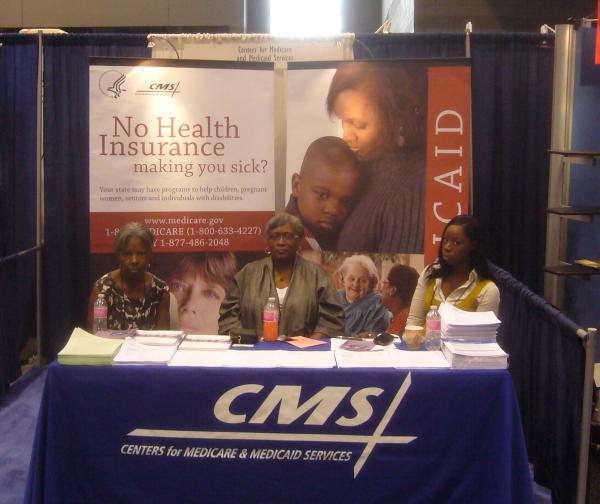
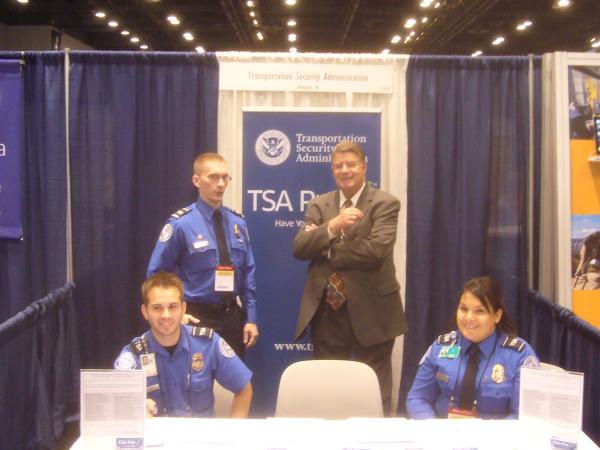

Forgetting for a moment the impediment to commerce and free association, how much money are we spending on these guys? Thanks to Gannett’s Asbury Park Press (h/t Bob Matter), taxpayers can access a database of reasonably current salary information for most Federal employees. For state and local employees in Illinois, Wisconsin, Indiana, and Missouri, the Better Government Association has made similar information accessible.
Government employee pensions are also an issue, and Taxpayers United of America is building a database of this information.
Now, I’m not opposed to high salaries and liberal pensions. In fact, I think everyone should get them. The problem is not that government compensation is too high, but that private compensation is too low. Some clear graphs here (based on data collected by government employees) illustrate the problem. Nongovernmental American workers’ productivity continues to increase, but for forty years little or none of this has been reflected in wages. The best remedy involves displacing the rentiers.
*Payroller is a Chicago term for folks whose main function is to collect a government paycheck. It appears that in some places, the word has a different meaning.
Just because they ask, doesn’t mean we have to give it to them
Governments here in Illinois (and probably everywhere else) like to “request” things, but that doesn’t mean we mundanes always need to grant these requests. Two examples from recent experience:
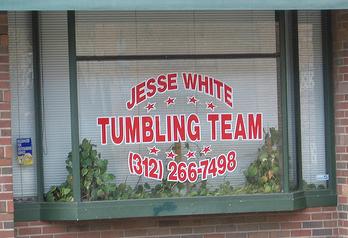
Saving money: Illinois Secretary of State Certificate of Good Standing. Our high-tech sophisticated Secretary of State makes it easy, relatively, to get the “certificate of good standing” that organizations may require, for example, to set up some kinds of financial accounts. No problem, just go to Jesse White’s web site, do a search (which really works, in my experience), fill out the simple form and authorize a credit card charge of $16 ($5 transaction fee, $1 payment processor fee, and $10 expedited fee). But suppose you aren’t in a great hurry and don’t need (or want to pay for) expediting. Or suppose you lack a credit card but have a checking account (or can buy a money order). What to do?
Nowhere could I find the answer on Jesse’s web site. Fortunately, cheapness wonk Adam Kerman of the Transit Riders’ Authority knew what to do:
Write a letter to request the Certificate of Good Standing. Make sure to include the corporate file number and your contact phone number. $5 fee Secretary of State Business Services 501 S. Second St., Rm. 330 Springfield, IL 62756
And that’s just what I did. A week or so later, the certificate arrived.

Saving Dignity: Regional Transportation Authority old person discount fare card. A good and privacy-minded friend of mine, having recently attained the age of 65, wanted to take advantage of the “reduced fares” available to old people (among others) on RTA-funded transit systems. First thing she found out was that it takes 3-4 weeks to get the required farecard, so she should have applied 21 days prior to her birthday. Too late for that, but she readily found the necessary form, which turns out to serve two functions: (a) apply for reduced fares based on age or other criteria; (b) apply for free fares based on likelihood of voting Democratic documented low income. Being successful enough not to qualify for (b), she still had to complete a form with a blank for “Social Security Number.” What do to?
She wrote “NOT REQUIRED” in the SSN blank, and 23 days later received a reduced fare card in the mail. Moral of this story: You can surrender somewhat less privacy than the authorities ask for, without giving up rights or privileges, at least in this case.
Public Revenue Education Council helps state officials learn about smart tax policies
What’s this? No posts for a month? Actually had several things “almost ready” to post, but meanwhile I spent an interesting three days at the National Council of State Legislators’ “Legislative Summit,” what most of us would call their annual convention.
Since about 1996, the Public Revenue Education Council (Missouri chapter of Common Ground — USA) has staffed a booth at the NCSL conference exhibit hall, alerting legislators, their staffs, and other attendees to the existence of a tax option which generates revenue while increasing, rather than discouraging, productive economic activity. Honing the message over the years (and gaining seniority which allows choice of better locations within the exhibit hall), PREC President Al Katzenberger and his colleagues may have gained some ground.
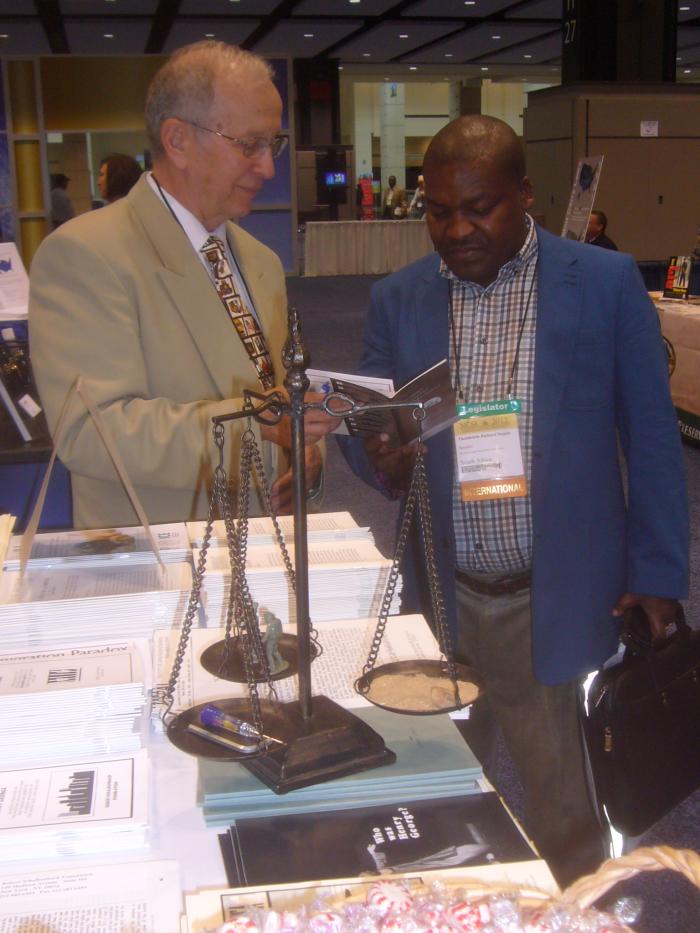
Among Al’s innovations is a custom-made (and unpatented, as far as I know) three-tray scale, used to illustrate the factors of production. Land, labor, and capital (the trays) are all necessary for most production, and usually use money (the chains) to facilitate the process. Banks and other financial institutions (the arms holding the chains) may try to manipulate the system unfairly, and it’s the job of government (the central post) to keep things more or less in balance.
For the 2012 event, which concluded Aug 9, Al was assisted by Don Killoren of St. Louis, Irene Marmi of Chicago, and this blogger. Since two people are generally enough to staff the booth, each of us had time to wander the hall visiting with other exhibitors– and there were many (a list is here). Why so many? As has been said: “No one’s liberty or property is safe while the legislature is in session,” so everyone wants legislators to do, or refrain from doing, something. Some exhibitors were interesting, and might be the subject of future posts.
Of course each of us has a slightly different view of what geoists want to accomplish, but we tried to present a unified message: “If you tax jobs, retail sales, and buildings, you’re likely to get less of those. If you tax the value of land as vacant, you’ll get economic benefits and, hey, let me tell you about much nicer your community will look.”
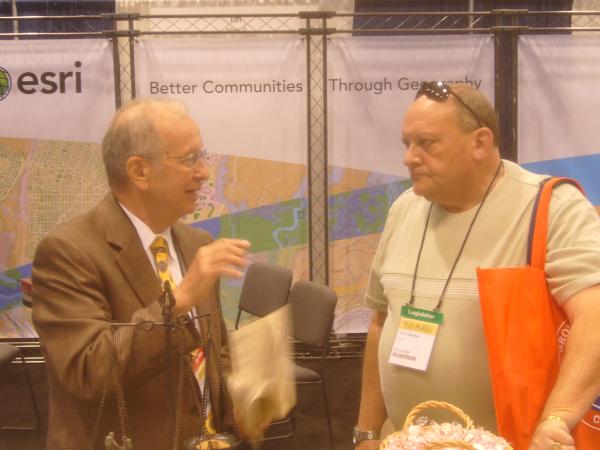
Few people might stop by a booth about public revenue, so Al and Don just call out to passers-by “Where are you from?” They reply, and Al or Don says “Oh, you could use this there.” But they’ve also learned (better than I) to just shut up and listen to each prospect, find out what their concerns are, and provide a helpful response.
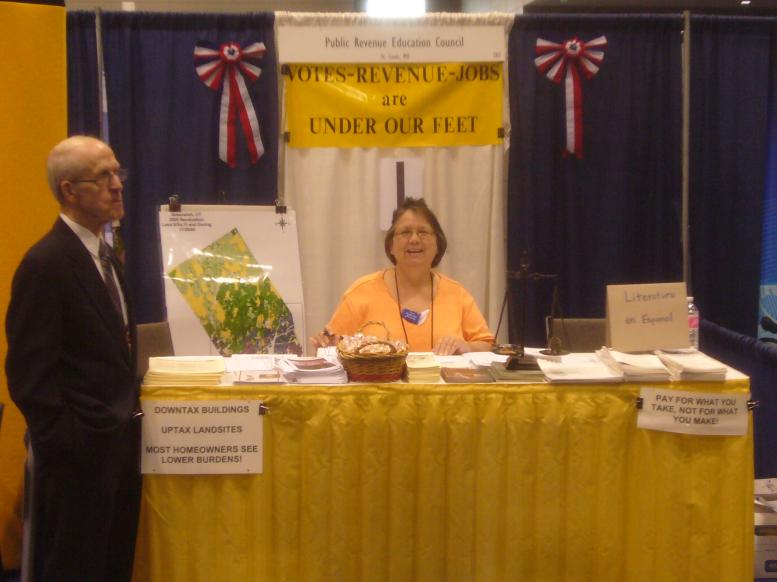
Thinking about next year’s NCSL conference (in Atlanta), we might want to seek a cleaner look by having fewer documents on the table. Plastic racks would be suitable for some of them. Others would be “under the counter,” or perhaps even available only on request via email. People will put their business cards in a fish bowl if a prize is offered. What prize? Maybe a $50 RSF gift certificate, along with some suggestions about what to spend it on. Use the business cards to generate an email list. Three days after the conference, everybody gets a “Thank you and call us if we can help” message. If they don’t respond, they won’t hear from us again until a week before the 2014 (Minnesota) conference, when we invite them to stop by our booth.
We need an attention-getting colorful postcard-size piece, highlighting our special web address which we’ll set up for the occasion, and perhaps a phone number. To the extent possible, the look of the documents we distribute should be modernized and made consistent. The Revenue Source is Under Our Feet seriously needs updating, and must include contacts for (not necessarily in) every state.
Across from the PREC booth was ESRI, the dominant geographic information systems software provider, who almost certainly were behind the Greenwich land value map we used to illustrate how straightforward land value assessment is. They suggested some contacts and ideas which may aid geoists in the future.
Economic divide is geographic, too

When I see the same theme coming from two different sources, I think there’s a trend (tho maybe it just means I wasn’t paying attention). And so we heard Meredith Whitney a few days back describing the developing divide of local and state governments, between those that are solvent (and can attract mobile, affluent residents and investors) and those spiralling down the debt hole. Now Al Lewis looks at it from the retail side– nobody wants to invest where the mundanes live, but as areas like Silicon Valley and Washington continue to prosper retail facilities are renewed and enlarged.
In a democracy of educated, thinking citizens, any state finding itself on the wrong side of this divide could reverse its decline simply by removing all taxes on wages, capital, purchases, and transactions in general, substituting a very heavy tax on land value (which ideally would include the value of mortgages on land, to be paid by the mortgage lender rather than the borrower). Unfortunately, the “investors” who control much of the land in declining areas have the resources to fool the electorate, or can work directly with elected officials to prevent effective reform.